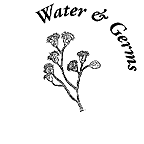
Introduction
1. What are germs?
2. Getting germs
3. Germ environment
4. Germ travel
5. Symptoms
6. Water's role
7. Water suppliers
8. Rules
9. Conclusion
Diseases & pathogens
Note on E. coli
| ON THIS PAGE: | Effective
sanitation stops the cycle Surface water vs. groundwater Surface water is never contaminant free Water and wild animals |
Under the proper (or rather, improper) conditions, drinking water can provide the link between hosts. An infected individual excretes millions of pathogenic microbes daily, and some of those may find their way into lakes or streams. If other people drink the contaminated water while the microbes are still viable, alive and able to reproduce, more people become infected. If each new case of infection produces ten more cases, the number of sick people increases exponentially (from one to ten to a hundred to a thousand). Such an event is an epidemic, rapid and extensive spread of infection among individuals.
|
A
special note about Influenza...
|
MWRA uses surface water collected in reservoirs as its drinking water supply. Other surface water sources include rivers, streams, lakes or ponds. The alternative to surface water is groundwater obtained from wells. Most large cities in the United States rely on surface water, while many smaller towns or individual homes depend on wells. These two sources are quite different with regard to biological contamination. Surface water is almost certain to carry some bacteria; groundwater from properly constructed and maintained wells is almost certain to be free of them. Rain may encounter animal waste on the surface, but as it seeps into the ground, microbes are filtered out by soils, sand and gravel before the water reaches the water table. When it is pumped to the surface, it has undergone nature's filtration.
Surface water is never contaminant free
Even
in normal circumstances, surface water bodies are certain to contain at
least some fecal organisms. Quabbin Reservoir is about as clean a source
of surface water one could find, but before treatment it isn't entirely
safe to drink. The animals in the watershed, from bear and beaver to geese
and gulls, constantly contribute waste (fecal matter) to the environment,
and runoff will certainly carry microbes into streams and thus to the
reservoir. If one of the animals carries an organism pathogenic to humans,
and people drink that water without taking preventive measures, they are
vulnerable to the illness.
Are the
people who drink the water certain to get sick? Not at all. Depending
on the pathogen, if only one or two such microbes are ingested, hopefully
the body's immune system will identify and defeat the invader. If a few
more microbes are ingested, that might make some people sick. In other
words, if everyone in a group swallows the same dose, some people may
get sick while others do not. Despite all the "maybes," one fact is certain:
the higher the concentration of pathogens in the water, the more people
are likely to get sick.
Do wild animals ever get sick by drinking from rivers and ponds?
There are several answers to this question:
- They sometimes do get sick, but we don't always know about it.
- Animals, like humans, tend to seek clean water sources. As you know, clean water is less likely to cary pathogens.
- Different microorganisms make different species sick. A virus that makes human beings sick might not have an effect on a deer or a raccoon.
 |
See
the kinds of germs we're talking about |
Lesson
7
>
|